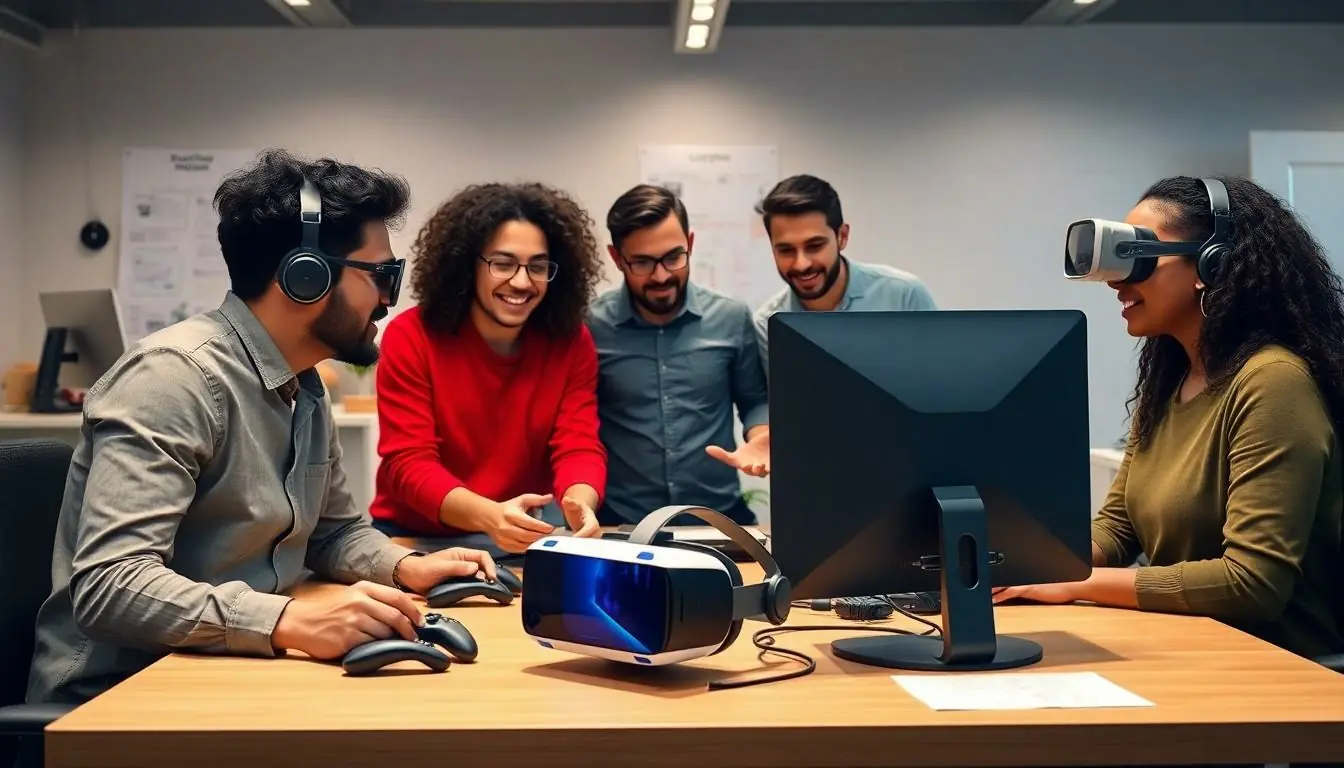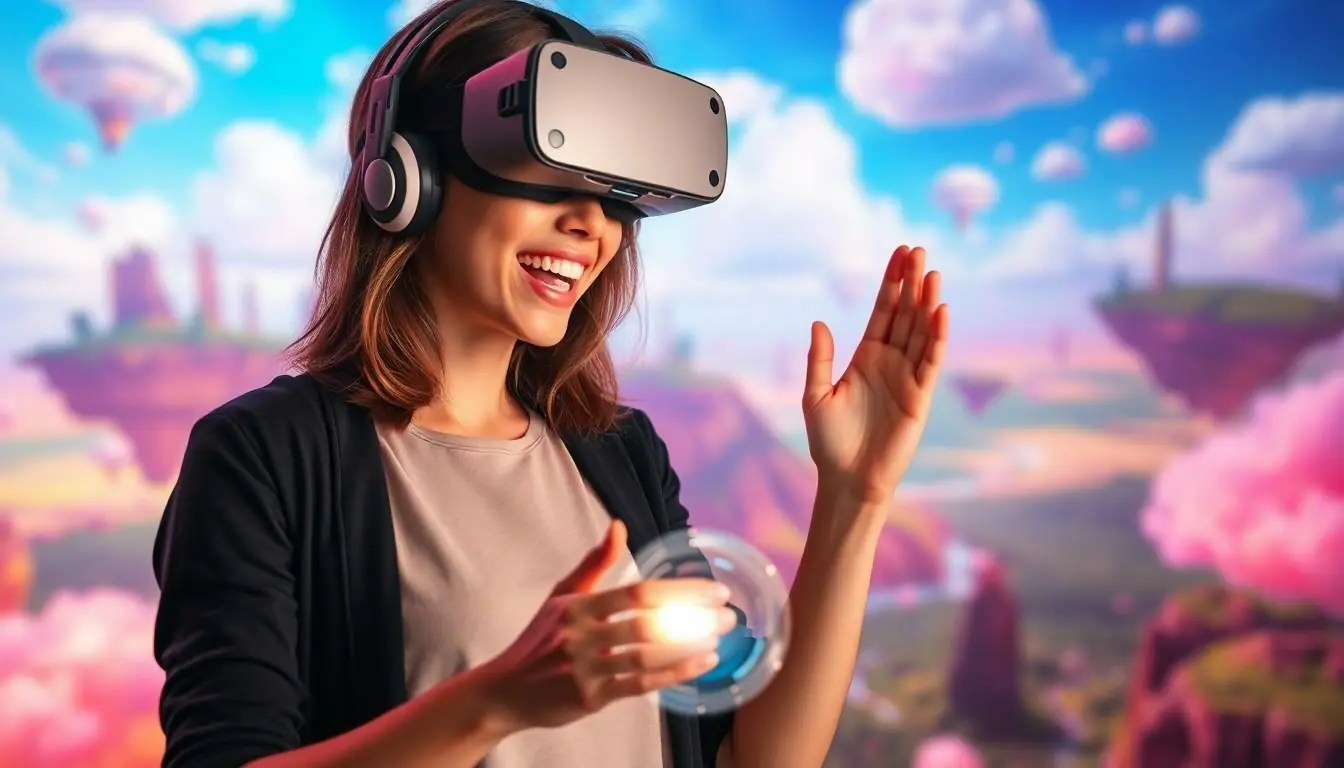In a world where reality can sometimes feel a bit too… well, real, virtual reality app development swoops in like a superhero with a cape made of pixels. Imagine diving into a digital ocean without getting your hair wet or exploring alien worlds while still in your pajamas. It’s not just a dream; it’s the future of technology, and it’s here to stay.
Developing virtual reality apps isn’t just about creating immersive experiences; it’s about crafting adventures that transport users to places they’ve only dared to imagine. Whether it’s gaming, education, or training simulations, the possibilities are endless. So, buckle up and get ready to explore how this exciting field is reshaping our interactions with technology and each other. After all, who wouldn’t want to escape reality every now and then?
Table of Contents
ToggleOverview of Virtual Reality App Development
Virtual reality app development plays a pivotal role in shaping immersive user experiences. The technology extends beyond entertainment, integrating into various sectors like education and training.
Importance of Virtual Reality in Today’s Technology
Virtual reality significantly enhances user engagement across multiple fields. It allows users to interact with digital environments in ways traditional media cannot replicate. Businesses leverage VR to create brand awareness and improve customer experience. Training programs utilize VR simulations for immersive learning, which boosts retention and understanding. Additionally, the healthcare sector employs VR for medical training and therapy sessions. As a result, the adoption of VR continues to grow, driving innovation forward.
Key Features of Virtual Reality Applications
Key features contribute to the effectiveness of virtual reality applications. High-quality graphics provide realistic visuals that immerse users in the experience. Real-time interaction supports seamless navigation and enhances engagement. Spatial audio further enriches the atmosphere, making environments feel more lifelike. User-friendly interfaces ensure accessibility, catering to both novices and experts. Cross-platform compatibility broadens the audience reach for VR applications, maximizing their impact. Continuous updates and support enhance functionality, keeping users engaged in evolving experiences.
Tools and Technologies for Development

Virtual reality app development relies on various tools and technologies to create captivating experiences. Understanding these resources is crucial for successful implementation.
Popular Development Platforms
Unity stands out as a leading platform for VR app development. It offers a user-friendly interface and extensive asset store, making it accessible for developers at all levels. Unreal Engine also gains popularity due to its impressive graphics capabilities and high-performance standards. Developers favor these platforms for their robust community support, providing tutorials and forums for troubleshooting. Other noteworthy platforms include Amazon Sumerian and A-Frame, both of which allow for rapid prototyping and integration with web technologies.
Programming Languages for Virtual Reality
C# serves as the primary programming language for Unity, allowing developers to script immersive behaviors and interactions. C++ is essential for Unreal Engine, enabling high-performance applications with complex functionalities. JavaScript plays a vital role in A-Frame and web-based VR applications, simplifying the development process for those familiar with web technologies. Additionally, Python is used in various VR tools and frameworks, offering flexibility for scripting. Each language contributes uniquely, adapting to different platforms and enhancing overall development efficiency.
Development Process
The development process of virtual reality applications consists of several critical stages that ensure successful implementation.
Conceptualization and Planning
This stage involves defining the app’s objective and target audience. Developers establish the core concept, defining features and functionalities for the VR experience. Researching market trends is essential at this point, as it informs the direction and design of the application. Competitor analysis helps pinpoint gaps in the market. Clear goals and a detailed project plan guide the development team throughout the process.
Design and Prototyping
Design and prototyping focus on creating an engaging user interface and immersive environments. Developers utilize tools like Unity and Unreal Engine for 3D modeling and mockups. Creating an interactive prototype allows for visualizing the user experience. This step also emphasizes user-centric design principles, ensuring the application is intuitive and accessible. Iterative design practices facilitate effective adjustments based on early feedback.
Testing and Feedback
Testing and feedback are crucial for identifying issues and enhancing user experience. Various testing methodologies, such as usability testing and performance testing, help evaluate the application’s functionality. Collecting user feedback through surveys aids in understanding user interaction. Developers prioritize critical feedback to implement necessary changes, refining the app before its final release. Continuous testing throughout the development lifecycle ensures a high-quality VR experience.
Best Practices in Virtual Reality App Development
Developers must focus on user experience and performance optimization to create effective virtual reality apps. Implementing these best practices helps ensure immersive and engaging applications.
User Experience Considerations
Designing for user experience is crucial in VR. Prioritize intuitive navigation, allowing users to feel comfortable exploring virtual environments. Incorporate interactive elements that respond promptly to user actions for seamless experiences. Provide clear instructions and feedback throughout the app to guide users effectively. Incorporating social features fosters community interaction, enhancing engagement. Consider accessibility options to accommodate diverse user needs and preferences, promoting inclusivity. User testing during development ensures that feedback directly influences design choices, creating a more satisfying experience.
Performance Optimization Techniques
Optimizing performance is essential for smooth VR experiences. Focus on reducing latency to avoid motion sickness, which can hinder user enjoyment. Utilize level-of-detail techniques to adjust graphic quality based on distance from objects in the scene. Implement efficient rendering methods like occlusion culling to enhance frame rates and minimize system load. Monitor memory usage and optimize asset sizes to maintain performance across devices. Regularly test the application on various hardware to identify and resolve performance bottlenecks, ensuring a consistently high-quality user experience.
Future Trends in Virtual Reality App Development
Virtual reality app development is evolving rapidly, driven by new technologies and diverse industry applications. These advancements shape the future landscape of VR.
Emerging Technologies and Innovations
Artificial intelligence enhances VR experiences by creating personalized, adaptive environments. Machine learning algorithms analyze user interactions, allowing apps to adjust in real-time. Moreover, advancements in haptic feedback technology immerse users into virtual worlds, providing realistic tactile sensations. 5G technology combines with VR to reduce latency, facilitating smoother and more responsive experiences. Additionally, cross-reality combines augmented reality with VR, broadening creative possibilities. Each innovation plays a crucial role in refining VR app development, enhancing user engagement and expanding outreach.
Industry Applications and Opportunities
Numerous industries capitalize on VR’s potential, leading to distinct applications. Healthcare utilizes VR for simulations and therapy, improving patient training outcomes. Education institutions adopt VR to create interactive learning environments, fostering deeper engagement for students. Real estate companies use virtual tours to showcase properties, attracting remote buyers effectively. Entertainment continues to thrive with immersive gaming experiences, pushing creative boundaries. Businesses in training and development increasingly implement VR for skill enhancement in safe, controlled settings. Each application presents unique opportunities, driving demand for innovative VR solutions.
The future of virtual reality app development holds immense promise as industries continue to explore its capabilities. With advancements in technology and an increasing demand for immersive experiences, developers have the opportunity to create innovative applications that enhance user engagement. By focusing on user-centric design and performance optimization, they can ensure that VR experiences are not only captivating but also accessible to a wider audience.
As VR evolves, integrating emerging technologies like artificial intelligence and 5G will further enrich these applications. This dynamic landscape invites developers to push boundaries and redefine how users interact with digital environments. Embracing these trends will be key to unlocking the full potential of virtual reality, making it an exciting field for both creators and users alike.

